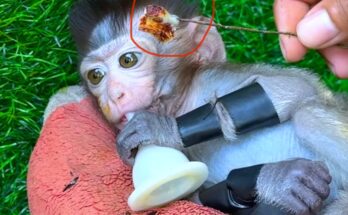When we think of monkeys, we often picture agile, intelligent creatures swinging through trees or interacting playfully with one another. But beneath their seemingly carefree nature lies a reality that researchers and wildlife experts are beginning to explore with increasing urgency: traumatic brain injuries (TBIs) in monkeys caused by collisions with hard surfaces.
This issue, though not widely discussed, is significant—especially in environments where monkeys come into frequent contact with human structures, vehicles, or other hard objects.
How Do These Injuries Occur?
Monkeys, particularly species such as macaques, capuchins, and vervets, are incredibly active. Their fast-paced movement, high jumps, and acrobatic play leave them vulnerable to accidents. In natural environments, falls from trees or territorial fights may lead to head trauma. However, in urban or semi-urban areas, the risks multiply.
Collisions with windows, metal poles, walls, or moving vehicles can result in severe brain trauma. Some monkeys, in unfamiliar or panic-inducing situations, may run headfirst into barriers while trying to escape perceived threats. Juveniles are especially at risk, as their bones and skulls are still developing.
Understanding the Monkey Brain
The primate brain is not unlike our own. It is complex, highly developed, and central to a monkey’s survival skills, memory, and social behavior. When the brain experiences trauma, whether through direct impact or rapid acceleration and deceleration (as in whiplash), the damage can range from mild concussion to permanent neurological deficits.
Common symptoms in monkeys include disorientation, unresponsiveness, unusual aggression or fearfulness, impaired motor skills, and even seizures. In wild populations, these symptoms often go unnoticed—until the affected monkey is no longer able to fend for itself.
Urbanization and the Rising Threat
As urban sprawl continues, the natural habitats of many monkey species are encroached upon. Human structures become playgrounds and foraging grounds, increasing the chances of injury. Additionally, roads and highways near monkey habitats create deadly zones where head injuries from vehicle collisions are tragically common.
In countries like India, Thailand, and parts of Africa, reports of monkeys suffering trauma from falls or impacts with buildings are on the rise. Sadly, many of these injuries are either fatal or leave the animals with long-term cognitive issues.
What Can Be Done?
There are growing calls from animal welfare groups and researchers to implement safety measures in high-risk zones. This could include:
- Wildlife overpasses and underpasses near highways.
- Monkey-friendly urban design with fewer reflective surfaces and hidden barriers.
- Public awareness campaigns about the dangers of feeding or chasing monkeys.
- Medical intervention and rehabilitation for injured primates where feasible.
In sanctuaries and research facilities, caretakers are being trained to recognize early signs of brain trauma and provide immediate care.
Conclusion
Monkey brain injuries from impacts with hard objects are a serious and underreported issue. As humans continue to reshape the environment, it is our responsibility to consider how our actions affect the wildlife that shares our space. Understanding and addressing the causes of these injuries is the first step toward protecting the health and wellbeing of these remarkable animals.


